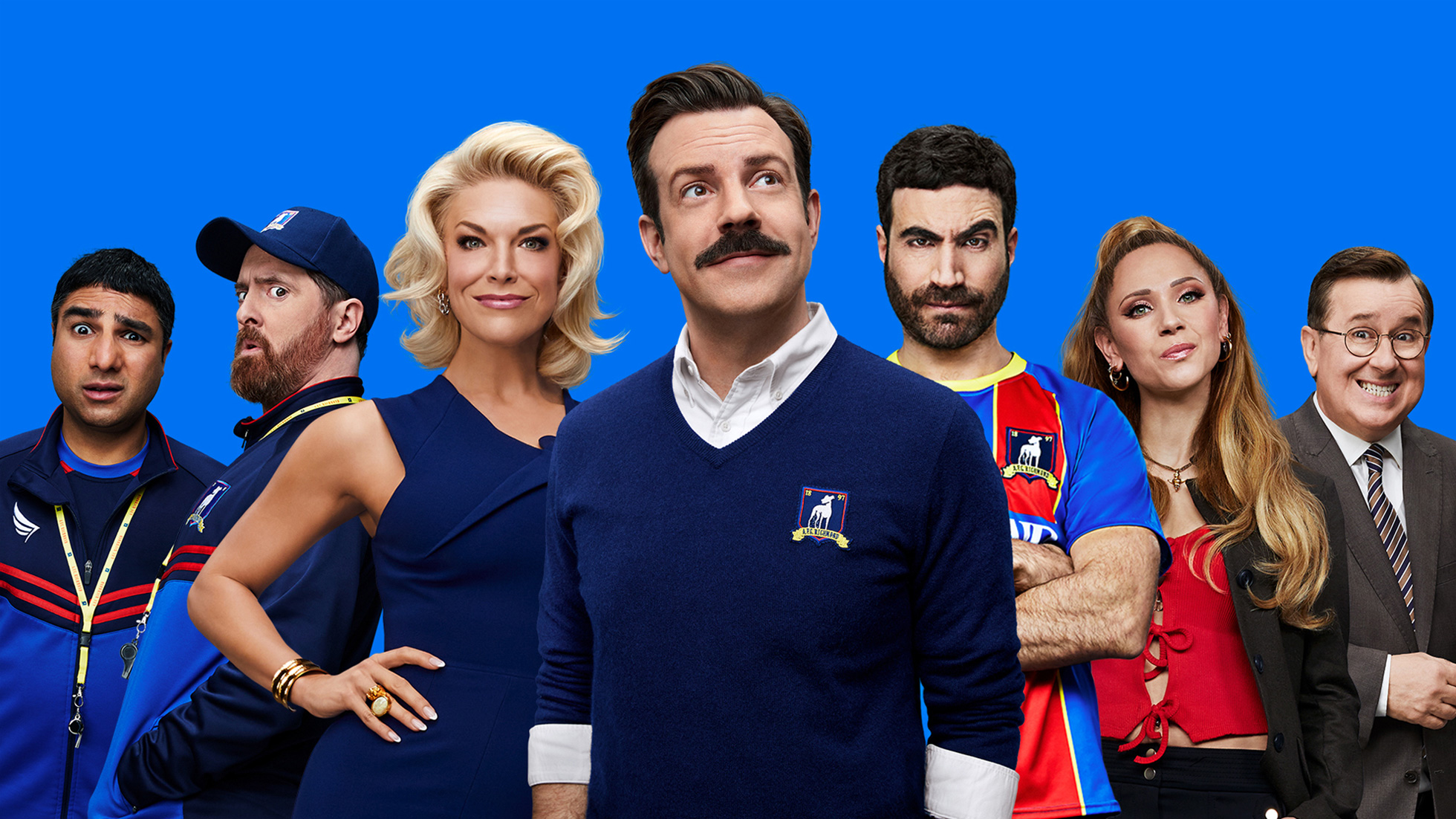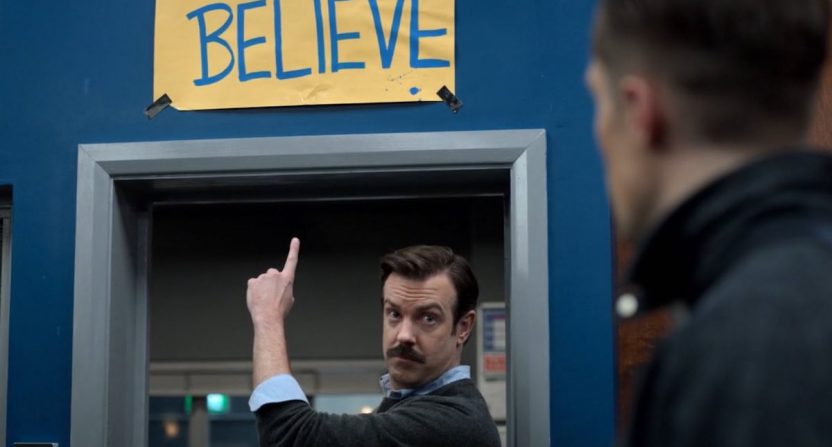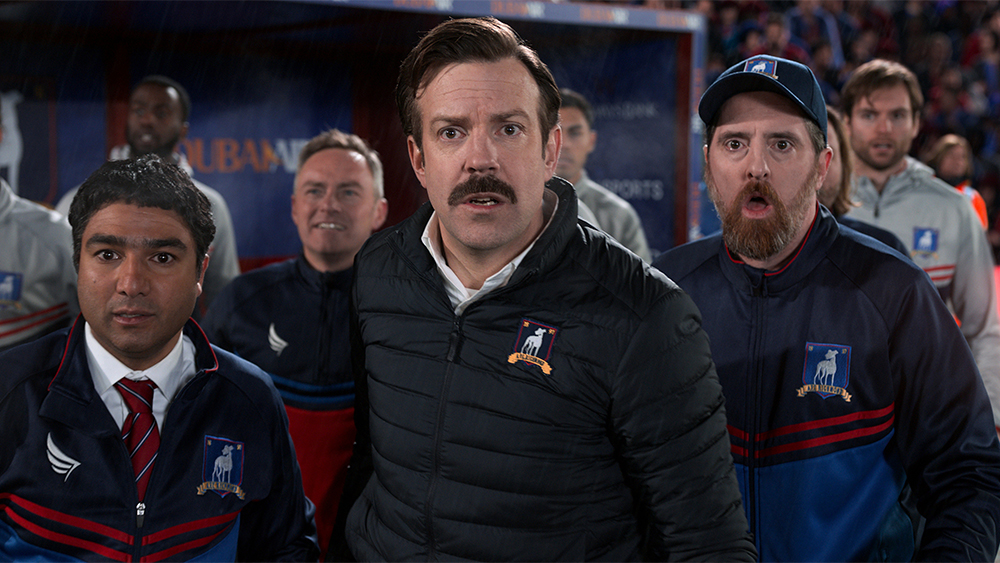I was watching an episode of Ted Lasso when it hit me: Is this secretly an Apple commercial?
All the characters carry iPhones. Rebecca has a MacBook on her desk. Dr. Fieldstone rocks AirPods when biking to work.
It gets even more meta. As a viewer, I'm watching Apple's show on my MacBook via Apple TV+. I'm sending quotes to friends (Football is Life!) from iPhone to iPhone. I even started listening to an Apple podcast about the show.
I hadn't stumbled into an Apple commercial. I was living inside of one.
By Kenny Wassus of the Wall Street Journal's count, "in one [Ted Lasso] episode — which was 29 minutes in length — there were 36 shots of Apple products. Which averages out to 1.24 Apple products per minute." There's more Apple products than soccer sorry, football footage!
And yet, all of this product placement floats pretty much under the radar. My reaction as an audience member is less, "I'm watching an infomercial," and more, "I'm watching one of the best comedies I've ever seen."
And, with 7 wins at the most recent Emmy's, Apple has found a way to make one of the best shows on TV while still subtly advancing their products.
What's their secret? Is this a show, a commercial, a product placement vehicle, or some unique form of content marketing?
And -- get ready for a big jump here -- how do these concepts apply to the world of B2B marketing?
Commercials and Product Placement

Traditional advertising usually fell into one of two buckets: Commercial or Product Placement.
Commercial - "Interrupt the show." Applies for TV, radio, podcasts, pop-ups on an online article, etc.
Product Placement - A non-disruptive appearance in someone else's content/media.
When I think of product placement, I think of Michael Jordan in Space Jam, the Subway commercial in Happy Gilmore, or the Talladega Nights' dinner table loaded with Dominos, KFC, and the always delicious Taco Bell.
In each of these scenarios, it's a brand "sneaking into" a movie. But, unlike a commercial, there's no interruption for the audience (major exception being Transformers: Age of Extinction, the 2014 winner of "Worst Product Placement," which crammed in 55 different brands!)
The mediums change - Radio to TV, newspapers to web pages, web pages to TikTok videos - but the concepts of running commercials and product placements remains relatively the same today as it was 50 years ago. For instance, In 2021, newspaper readership is way down and traditional cable TV has taken a hit, but we still see plenty of commercials on YouTube videos and product placement is going strong via influencers on social media.
Both of these tools (commercials and product placement) can be great for raising brand awareness, but in terms of directly generating leads, it's hard for a marketing team to track the direct impact.
Content Marketing: You don't have to interrupt when it's your own channel

Content Marketing is not a new phenomenon. In Joe Pulizzi's book, Epic Content Marketing, he goes all the way back to 1895 as one of the earliest examples of this type of strategy.
"Deere & Company, arguably the most famous agricultural company in the world, launched, created, and distributed The Furrow magazine in 1895. Deere leveraged The Furrow, not to sell John Deere equipment directly (as a catalog would do), but to educate farmers on new technology and how they could be more successful business owners and farmers (thus, content marketing)."
Instead of searching for the leading farming magazine, and then buying up ad space, Deere & Company went out and created the magazine themselves. And now, "120 years later, The Furrow is the largest circulated farming magazine in the world, delivered monthly to over 1.5 million farmers."
The key to content marketing is creating your own channel and then not using it as an infomercial. Create helpful, insightful, and/or entertaining content covering topics your audience cares about. This will sound a little Field of Dreams-y but "if you build it, the sales will come." You don't have to sneak a sales pitch into your content.
Tying it back to Ted Lasso

Apple decided to launch their own streaming service called Apple TV+.
One approach they could've done is bought the rights to shows like Friends, Seinfeld, Breaking Bad (Apple's got plenty of money to do it) and then paid for a bunch of commercials to promote their new streaming service.
Instead, they chose to create their own TV shows, the most successful one being Ted Lasso.
The main goal of Ted Lasso wasn't to sell Apple products, it was to create an awesome show that people would tell their friends about and then more people sign up for Apple TV+.
Ted Lasso is, in a sense, like a commercial for Apple TV+. It's also product placement because of all the Apple products featured in each episode. But I think it qualifies most as content marketing. Reason being: It's great content that people will enjoy and share with each other. This generates new leads and new customers, which Apple can track and see how many new subscribers are watching Ted Lasso. The show ends up being a really funny and creative marketing funnel.
Okay, so then what does this have to do with B2B marketing?

Should all B2B companies reach out to Jason Sudeikis and see if he'll help create a multimillion dollar TV show? Hey, it's worth a shot!
But in all seriousness, you can apply these same concepts to eBooks, webinars, your own magazine, or a podcast. Here's how to get started. Start by making a list of questions your customers/prospects have. What would they find interesting? And what could you specifically help them with?
Deere & Company didn't need to create Ted Lasso, or a magazine about how to make ice cream, because both those things -- albeit cool ideas -- are not in their product space. The content you create should be within your area of expertise and at least indirectly point back to your products/services (notable exceptions being the Michelin Restaurant Guide and the Guinness book of World Records. Both are famous examples of content marketing even though they don't tie directly back to car tires or Guinness beer).
Three companies who are doing content marketing really well today who I see a lot on LinkedIn are Gong, Hubspot, and Jellyvision.
Gong has a bunch of tips for improving your BDR/SDR and AE performance.
Hubspot has a lot of content on sales, marketing, and CRM.
Jellyvision produces content on employee benefits and healthcare.
The people interested in this type of content are also their prospective buyers. Just like Ted Lasso driving people to Apple TV+, these three companies' content drives audience back to their websites where they might stay and click around, check out other things, maybe fill out a contact form. Or, if/when one of their sales rep reaches out, the prospect will be more likely to take a meeting since they've already interacted with multiple pieces of content.
In Epic Content Marketing, they reference the importance of having prospects become familiar with your content prior to a demo.
"According to Google's Zero Moment of Truth research, in 2010 the average consumer engaged with 5 pieces of content before making a buying decision. In 2011, that number doubled to more than 10."
I imagine this number will continue to climb, especially with the rise of LinkedIn over the last few years.
And just like Ted Lasso, you don't want it to feel like an infomercial. Whatever you create -- webinar, eBook, blog post, podcast -- it should be high quality work that looks like something a professional media company would produce. In fact, both Joe Pulizzi and Gary Vaynerchuk recommend your content marketing department (or an outside partner) function like its own media company. It's worth hiring former journalists, directors, actors, comedians, book publishers to take on these roles and build your new "media empire."
Mentioned Gong earlier, their content is so good that people who don't even work for Gong re-share it on LinkedIn. That's a great sign you've created a professional, high-quality, thoughtful piece of content. It's like people sharing Ted Lasso quotes, there's no financial incentive, they just love the show.
So, it's worth asking yourself or your marketing team:
"Do we have 10+ pieces of content that a prospect could consume next year?"
"If not, how do we get there? Do we have the right people on staff?"
"Are we working on anything that could become the best podcast, publication, or resource -- not just within our industry -- but in all of the online search results?"
It's never too late to get started. We have a few resources on our site as a starting point. For example, here's how you can turn one webinar into 20 pieces of content. And here's how to shift your webinar "pregame" and "postgame" strategy.
But, most importantly, you gotta believe you can do it.

For more help with content marketing, subscribe to our blog below. You can also reach out to us directly via email or calling our main line at 312-283-4653.dia
